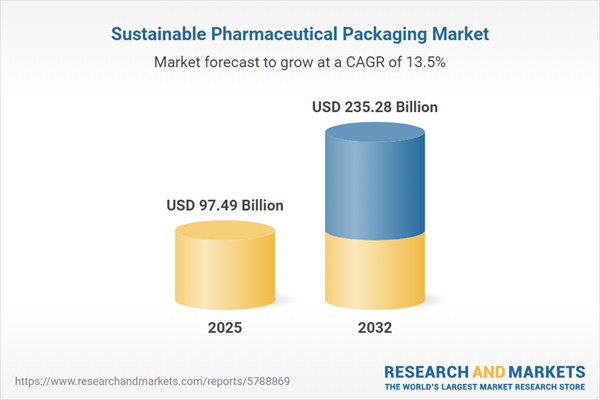Speak directly to the analyst to clarify any post sales queries you may have.
Sustainable pharmaceutical packaging is reshaping how pharmaceutical companies meet operational, regulatory, and environmental objectives across complex supply chains. Senior leaders are re-evaluating packaging strategies to support compliance and resilience while advancing sustainability in rapidly changing healthcare markets.
Sustainable Pharmaceutical Packaging Market Snapshot
The sustainable pharmaceutical packaging market is showing robust growth, valued at USD 85.70 billion with projections indicating USD 97.49 billion next year and potential to reach USD 235.28 billion by 2032. This growth trajectory is fueled by an annual compound growth rate of 13.45%. Industry adoption is accelerating as eco-friendly packaging materials become central to operational models and as regulatory guidelines continue to evolve for enhanced transparency and product safety. Organizations aiming for competitiveness are embedding sustainable practices in their packaging design, not just to comply but also to reinforce their supply chain integrity and foster stakeholder trust in environments with rigorous standards.
Scope & Segmentation of Sustainable Pharmaceutical Packaging
- Packaging Types: Ampoules crafted from glass or plastic, a choice aligned with diverse stability requirements. Blister packs—using paper or PVC aluminum—and PVdC formats, as well as a range of bottles (glass and plastic), pouches (foil or paper), and vials, each engineered to preserve product efficacy and ensure strict compliance in different pharmaceutical applications.
- Material Types: Biodegradable plastics such as PHA, PLA, and starch-based compounds enable reduced environmental impact. Multiple glass variants, including borosilicate and flint, metals like aluminum and steel, and paper-based substitutes such as corrugated board and kraft paper are integrated based on needs for compliance, logistics, and safety.
- Drug Types: Market demand spans liquids, semi-solids (including creams, gels, ointments), and solid forms (capsules, tablets), each requiring bespoke packaging approaches to balance sustainability with robust product protection.
- End Users: Hospitals, clinics, retail and online pharmacies, and research laboratories each have distinct needs driven by sustainability objectives, storage optimization, and adherence to health and safety requirements.
- Technologies: Pulse adoption of active and intelligent packaging—incorporating oxygen and ethylene scavengers, digital innovations like NFC, QR codes, RFID, and advanced atmosphere or vacuum controls—enables better traceability and supports waste reduction efforts.
- Regions: Coverage includes the Americas, Europe, Middle East, Africa, and Asia-Pacific. Each region’s regulatory framework and infrastructure maturity influence the speed and manner of sustainable packaging integration, shaping global deployment trends and strategy.
- Key Companies: Market influence and ongoing innovation stem from industry leaders such as Amcor plc, Berry Global Group, Mondi plc, Gerresheimer AG, West Pharmaceutical Services, AptarGroup, SCHOTT AG, Constantia Flexibles Group, Tekni-Plex, and ALPLA Werke Alwin Lehner GmbH & Co KG, setting standards for sustainable packaging practices and adoption.
Key Takeaways for Senior Decision-Makers
- Sustainable pharmaceutical packaging is emerging as a core differentiator, fueling alignment with compliance requirements and supporting an accountable corporate strategy across supply chains.
- Evolving regulatory conditions worldwide are prompting organizations to reassess sourcing, procurement, and manufacturing strategies for a holistic approach to sustainability.
- Diversification in drug formulations is encouraging innovation in packaging solutions that balance conservation of material and optimized protection to support business objectives.
- Digital traceability—enabled by QR codes, RFID, and other features—is improving supply chain oversight and mitigating operational risks across variable regulatory landscapes.
- Partnering with suppliers and value-chain stakeholders advances the scalability of circular packaging models and strengthens resource efficiency initiatives.
- Distinct market and regulatory conditions in each global region demand tailored strategies for integrating sustainable packaging, influencing rollout speed and process adoption across multinational operations.
Tariff Impact: Navigating U.S. 2025 Policy Shifts
Upcoming U.S. tariffs targeting imported substrates of glass, plastic, and metal are compelling companies to diversify their supplier bases and consider near-shoring as part of their risk mitigation. Proactive shifts—especially around critical materials like borosilicate vials and aluminum containers—are underway to sustain uninterrupted supply. Analytics-driven inventory strategies are key for reducing exposure to duty volatility under changing trade policies.
Methodology & Data Sources
This market analysis synthesizes primary executive interviews, comprehensive secondary research, and interactive stakeholder workshops. Triangulation of these methods ensures findings are directly relevant to current market realities and the evolving dynamics of sustainable pharmaceutical packaging.
Why This Report Matters
- Enables leadership teams to anticipate how sustainable pharmaceutical packaging will shape future regulatory and market environments.
- Delivers pragmatic approaches for managing supply chain risk, boosting innovation, and building supplier collaboration throughout the pharmaceutical ecosystem.
- Supports efficient investment and strategic planning with insights detailed by technology, end user profile, and regional regulatory context.
Conclusion
Sustainable pharmaceutical packaging continues to drive compliance and operational advantage. Organizations prioritizing partnership and forward-looking innovation will sustain resilience as standards and regulations evolve.
Additional Product Information:
- Purchase of this report includes 1 year online access with quarterly updates.
- This report can be updated on request. Please contact our Customer Experience team using the Ask a Question widget on our website.
Table of Contents
3. Executive Summary
4. Market Overview
7. Cumulative Impact of Artificial Intelligence 2025
List of Figures
Samples

LOADING...
Companies Mentioned
The key companies profiled in this Sustainable Pharmaceutical Packaging market report include:- Amcor plc
- Berry Global Group, Inc.
- Mondi plc
- Gerresheimer AG
- West Pharmaceutical Services, Inc.
- AptarGroup, Inc.
- SCHOTT AG
- Constantia Flexibles Group GmbH
- Tekni-Plex, Inc.
- ALPLA Werke Alwin Lehner GmbH & Co KG
Table Information
| Report Attribute | Details |
|---|---|
| No. of Pages | 183 |
| Published | October 2025 |
| Forecast Period | 2025 - 2032 |
| Estimated Market Value ( USD | $ 97.49 Billion |
| Forecasted Market Value ( USD | $ 235.28 Billion |
| Compound Annual Growth Rate | 13.4% |
| Regions Covered | Global |
| No. of Companies Mentioned | 11 |









